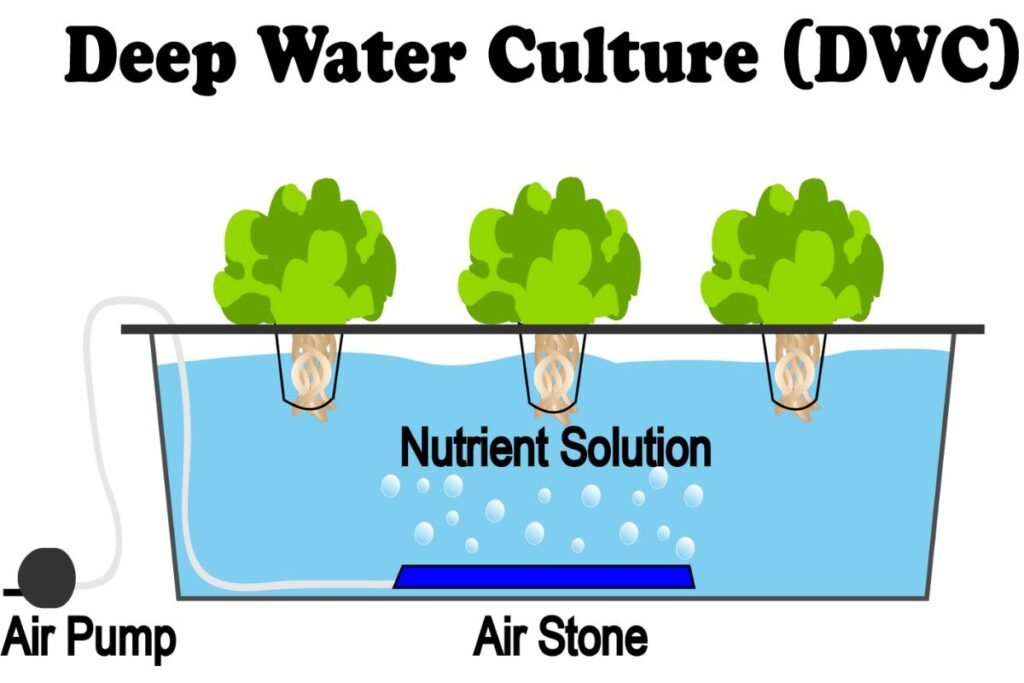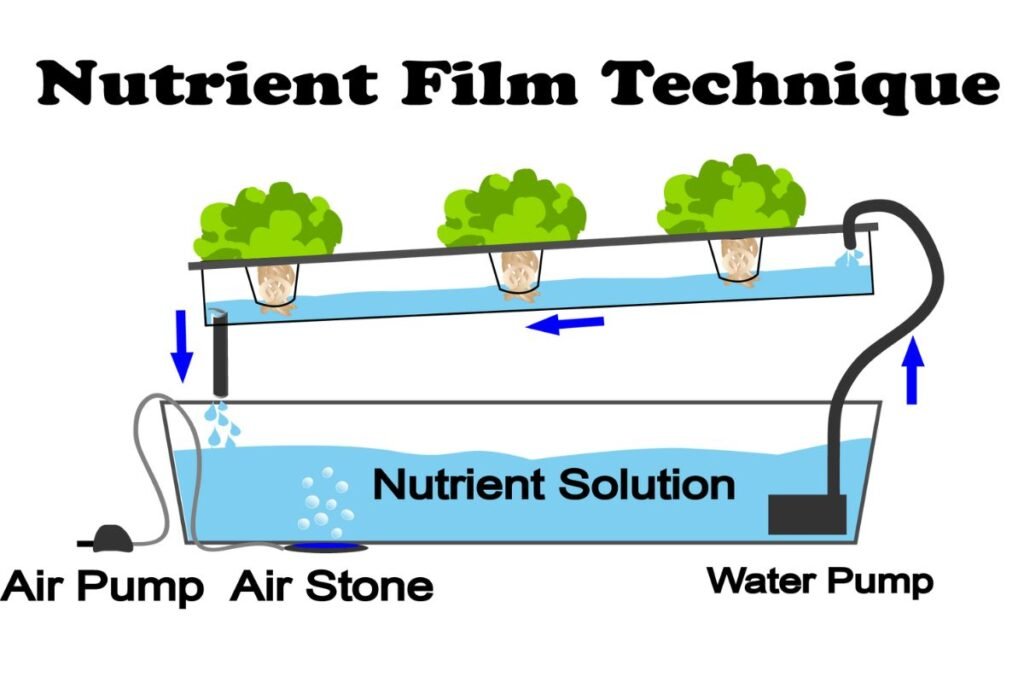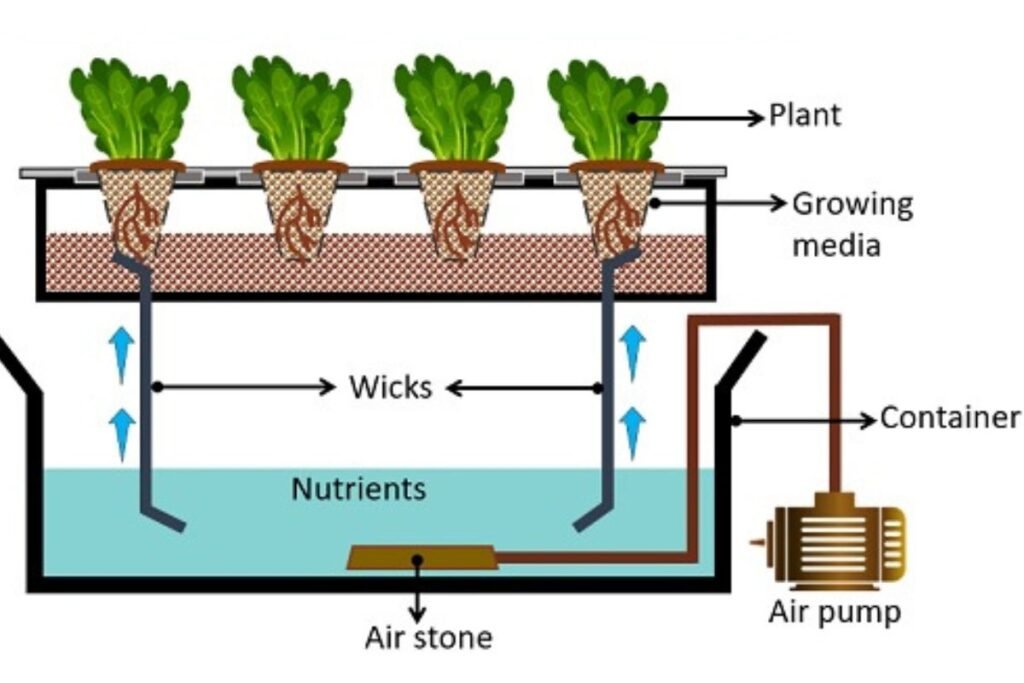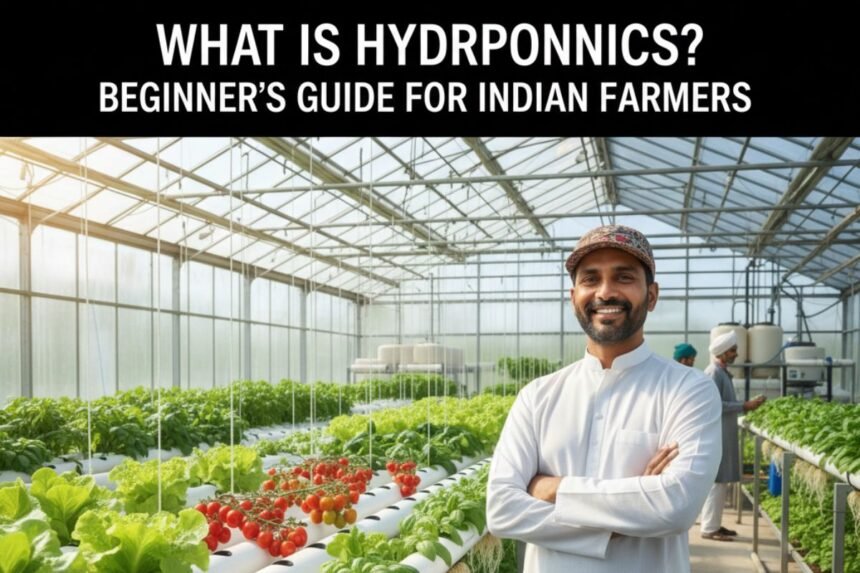You know that sinking feeling when you check the weather forecast and there’s no rain predicted for weeks? Or when you look at your small piece of land and wish you could somehow grow more to feed your family and make a better income?
- So, What Exactly is Hydroponics?
- Why Should We Indian Farmers Even Care About This?
- How Does This Actually Work? Let Me Break It Down
- Types of Hydroponic Systems for Beginners
- What Can You Actually Grow?
- Getting Started – What Do You Actually Need?
- Common Concerns – Let Me Address Them
- Real Farmers Are Doing This in India
- Should You Try It?
- Why Choose Hydroponics?
I’ve been there. We all have.
Last summer, my neighbor Rajesh bhai was really worried. His tomato crop was struggling because of irregular rains, and the groundwater level in our area had dropped so much that even tube well water was becoming expensive. That’s when he told me about something called hydroponics, and honestly, I thought he was joking at first.
Growing vegetables without soil? In water? It sounded like something from a science fiction movie, not real farming.
But here’s the thing after learning more about it and seeing it work with my own eyes, I realized this might be something that could help many of us. So let me share what I’ve learned, and maybe it’ll help you too.
So, What Exactly is Hydroponics?
Let me explain this in the simplest way possible.
You know how we normally grow crops in soil, right? The soil holds the plant, and the roots take water and nutrients from it. Well, in hydroponics, we skip the soil completely. Instead, we grow plants in water that’s mixed with all the nutrients the plants need.
Think of it like this when you make chai, you add all the ingredients (tea, milk, sugar, masala) directly into the water, right? Hydroponics is similar. We add all the nutrients the plants need directly into the water, and the plant roots sit in this nutrient-rich water.
The word “hydroponics” comes from two Greek words “hydro” meaning water, and “ponos” meaning labor or work. So basically, it’s making water do the work of feeding your plants.
I know what you’re thinking “But don’t plants need soil to grow?” That’s what I thought too! But actually, plants don’t really need soil itself. They need the nutrients, water, and support that soil provides. In hydroponics, we give them all of these things in different ways.
Why Should We Indian Farmers Even Care About This?
Look, I’m not here to say that our traditional farming methods are wrong. Our ancestors have been farming on this land for thousands of years, and there’s deep wisdom in those methods. But we’re also facing challenges today that they didn’t have to deal with.
Let me tell you why hydroponics might be worth considering, especially for us in India.
Water is Becoming Gold
You’ve seen it yourself water scarcity is a real problem now. Whether you’re in Maharashtra, Karnataka, Rajasthan, or anywhere else, water is becoming harder to get and more expensive every year.
Here’s something that shocked me: hydroponic farming uses about 90% less water than traditional farming. Yes, ninety percent! How’s that possible when you’re growing in water? Because in traditional farming, so much water is wasted it evaporates, runs off, or seeps deep into the ground where roots can’t reach it. In hydroponics, the water is in a closed system, circulating back to the plants. Whatever the plants don’t use, you can use again.
For areas where water is scarce, this is huge.
Small Space? No Problem
Not all of us have acres and acres of land. Maybe you have a small plot, or you’re thinking of starting something on your terrace or in your backyard. With hydroponics, you can grow a lot more in a much smaller space.
I’ve seen setups where people are growing vegetables vertically stacking the plants on top of each other like floors in a building. On the same land where you might grow 100 plants traditionally, you could grow 300 or even 500 plants with vertical hydroponics.
This is especially good for people in cities or those who have small pieces of land but want to start farming.
Weather Won’t Control You Anymore
Remember how unpredictable the weather has become? Sometimes the monsoon comes late, sometimes it’s too heavy, sometimes it doesn’t come at all. Summer is getting hotter, and cold waves come unexpectedly.
With hydroponics, especially if you set it up in a protected environment like a greenhouse or poly house, you’re much more in control. The weather outside can do whatever it wants, but your crops are safe inside. You can grow tomatoes in summer, leafy vegetables in monsoon whenever you want.
Better Yields, Better Quality
Because you’re controlling exactly what nutrients the plants get, and they’re getting optimal conditions, the plants often grow faster and healthier. Many farmers report getting 25-40% higher yields compared to traditional farming.
Plus, the vegetables often look cleaner and fresher because they’re not sitting in soil. This can help you get better prices in the market.
Grow Off-Season Crops
Imagine selling tomatoes when everyone else’s crop has finished and prices are high. Or growing English vegetables like lettuce, which usually grow in cool weather, even during hot months. With hydroponics in a controlled environment, you can grow crops outside their normal season and get premium prices.
How Does This Actually Work? Let Me Break It Down
Okay, so now you’re probably wondering how do you actually do this? Let me walk you through the basics.
The Plant Support
Since there’s no soil, the plant needs something to hold it upright. Usually, we use things like coconut coir (the fiber from coconut shells), clay pebbles, or even just plastic baskets with holes. The plant sits in this support material, which doesn’t provide any nutrition it just holds the plant in place.
The Nutrient Solution
This is the heart of hydroponics. You mix special fertilizers (nutrients) in water to create what’s called a “nutrient solution.” Don’t worry these nutrients are not some complicated chemicals. They’re basically the same minerals that plants get from soil, but in a form that dissolves easily in water.
You can buy ready-made nutrient mixes these days. They come with instructions on how much to add to water, just like mixing fertilizer for regular farming.
The Water System
The nutrient-rich water needs to reach the plant roots. Different hydroponic systems do this in different ways – some keep the roots sitting directly in the water, some spray the water on the roots, and some let water flow past the roots. I’ll explain the different systems in a bit.
Air for the Roots
Here’s something important roots need oxygen too, not just water and nutrients. In soil, there are tiny air pockets between soil particles. In hydroponics, we need to make sure the roots get air. Some systems do this by not submerging the roots completely in water. Others use air pumps (like the ones in fish aquariums) to bubble air through the water.
That’s basically it! Plants in a support medium, roots getting nutrient-rich water, and making sure they get air. Simple, right?
Types of Hydroponic Systems for Beginners
Now, there are several types of hydroponic systems, and honestly, some of them can get complicated. But let me tell you about two or three systems that are easy to start with and work well for beginners in India.
Deep Water Culture (DWC) – The Simplest One
This is probably the easiest system to understand and set up. Imagine a bucket or container filled with nutrient solution. The plant sits in a basket on top, with its roots hanging down into the water. An air pump (like in fish tanks) bubbles air through the water so the roots get oxygen.
This is great for beginners because it’s simple and cheap to set up. You can start with just a few buckets and grow plants like tomatoes, chillies, or leafy vegetables. Many people in India start with this system on their terrace or balcony.
The only thing to watch is making sure the air pump keeps running and the water level stays right.

Nutrient Film Technique (NFT) – The Commercial System
This is the system you’ll see in many commercial hydroponic farms. In NFT, plants sit in channels or pipes, and a thin film of nutrient solution constantly flows past their roots. The water is pumped from a tank, flows through the channels where the plants are, and then drains back into the tank to be used again.
It sounds more complicated than DWC, but once it’s set up, it’s very efficient. This system is good if you’re thinking of growing leafy vegetables like lettuce, spinach, or herbs on a slightly larger scale.
The setup cost is a bit more, but it’s still manageable, and many farmers in cities like Bangalore and Pune use this system successfully.

Wick System – The No-Electricity One
Here’s an interesting one if you’re worried about electricity or want something super simple. In a wick system, the plant sits in a growing medium (like coconut coir), and wicks (like cloth strips or ropes) hang down into the nutrient solution. The wick pulls the water up to the plant roots, just like how a diya absorbs oil.
No pumps, no electricity needed. It’s perfect for small scale growing and for plants that don’t need too much water. The only downside is it works best with smaller plants and might be too slow for larger, thirsty plants.
You don’t need to start with anything fancy. Many successful hydroponic farmers in India started with just a few buckets and some simple equipment.

What Can You Actually Grow?
This is the exciting part what vegetables can you grow with hydroponics in India?
Leafy Vegetables
These are the easiest to start with and grow really well in hydroponics. Think lettuce, spinach (palak), fenugreek (methi), coriander (dhania), mint (pudina), and other herbs. They grow fast, don’t need much space, and there’s good demand in cities.
Many restaurants and hotels in cities like Mumbai, Delhi, and Bangalore are specifically looking for fresh, clean leafy vegetables, and they’re willing to pay premium prices.
Tomatoes
Tomatoes love hydroponics! They grow really well and you can get good yields. Cherry tomatoes, especially, are popular and fetch good prices.
Capsicum and Chillies
Both bell peppers (capsicum) and chillies do excellently in hydroponic systems. The colorful capsicums especially can get you good prices because they’re expensive in the market.
Cucumbers
Cucumbers grow fast and produce a lot in hydroponic systems. They’re also easy to sell in any market.
Strawberries
If you’re near a city or tourist area, strawberries can be very profitable. They’re expensive, and growing them hydroponically gives you clean, beautiful fruit.
Other Options
You can also grow beans, peas, cauliflower, broccoli, and even some flowers. Basically, if it’s not a root vegetable (like potatoes or carrots), you can probably grow it hydroponically.
Start with something simple like leafy vegetables or tomatoes. Get comfortable with the system, understand how it works, and then try other crops.
Getting Started – What Do You Actually Need?
Let me be practical here and talk about what you’ll need and what it might cost.
Basic Equipment
For a simple Deep Water Culture system for beginners, you’ll need:
- Containers or buckets (you can even reuse old buckets)
- Net pots or baskets to hold plants
- Growing medium (coconut coir is cheap and easily available in India)
- Nutrient solution (available online or in agriculture stores)
- Air pump and air stones (like aquarium pumps – ₹500-1000)
- pH testing kit (₹300-500)
Estimated Costs
For a very small terrace setup with maybe 10-15 plants, you can start with around ₹5,000-10,000. This includes everything you need to get going.
If you want to go a bit bigger maybe 50-100 plants in an NFT system you’re looking at around ₹30,000-50,000.
For a small commercial setup with a greenhouse or net house and around 500 plants, the cost might be ₹2-3 lakhs. But remember, you can also get subsidies from the government for greenhouse structures in many states.
Where to Get Supplies
These days, you can find hydroponic supplies online on websites like Amazon, Flipkart, or specialized hydroponics stores. There are also some good Indian companies now selling complete kits and supplies.
Many agriculture universities and Krishi Vigyan Kendras (KVKs) are also starting to provide training and information about hydroponics.
My Advice – Start Small
Don’t invest a lot of money right away. Start with a few buckets, maybe 5-10 plants. Learn how it works. Understand the nutrient mixing, the pH balance, how to spot problems. Once you’re comfortable and seeing success, then scale up.
I know farmers who started with just a small setup on their terrace growing leafy vegetables for their own family. Within a year, they expanded and now they’re supplying to restaurants and organic stores in their city.
Common Concerns – Let Me Address Them
Whenever I talk to fellow farmers about hydroponics, I hear the same worries. Let me try to answer them honestly.
“Isn’t It Too Expensive?”
Yes, the initial setup costs more than traditional farming. But think of it this way – you’re using much less water, no pesticides or very minimal pesticides, less labor, and getting higher yields. Many farmers recover their investment in 1-2 years.
Plus, you can start very small with minimal investment and grow from there.
“It Sounds Too Complicated”
I felt the same way! But honestly, once you understand the basics, it’s not that hard. You’re basically just making sure plants get water, nutrients, and air. Yes, you need to check pH levels and nutrient concentrations occasionally, but it becomes routine quickly.
Think of it like learning to ride a motorcycle seems scary at first, but becomes natural with practice.
“Will People Buy These Vegetables?”
This is a good question. In cities, especially among educated consumers, there’s growing demand for clean, fresh, pesticide-free vegetables. Many people are willing to pay more for quality.
Restaurants, hotels, and organic stores are particularly interested in hydroponic produce because it’s clean and consistent in quality.
That said, you need to identify your market before you start. Don’t grow something nobody wants to buy!
“What If the Electricity Goes?”
This is a real concern in many parts of India. For systems that need pumps, you might need to invest in a small battery backup or inverter. Some farmers use solar panels to run their systems.
Or you can start with a wick system that doesn’t need electricity at all.
“What About the Taste?”
I’ve heard people say hydroponically grown vegetables don’t taste as good. Honestly, in my experience and from what other farmers tell me, if you’re using good quality nutrients and growing the plants properly, the taste is just as good, sometimes even better because the plants are healthier.
Real Farmers Are Doing This in India
I’m not just talking theory here. Farmers across India are actually doing this and succeeding.
In Bangalore, there are farmers growing lettuce and exotic vegetables for five-star hotels. In Pune, someone started with just a small terrace setup and now supplies fresh herbs to restaurants. In Hyderabad, farmers are growing strawberries hydroponically and selling them at premium prices.
Even in smaller towns, farmers are starting to experiment with hydroponics, especially for growing off-season vegetables or English vegetables that usually need cooler climates.
The government is also starting to support this. Some state governments offer subsidies for protected cultivation, and agricultural universities are conducting training programs.
Should You Try It?
Here’s what I honestly think.
Hydroponics isn’t going to replace traditional farming, and it’s not a magic solution to all farming problems. But it’s definitely a useful tool, especially if you’re dealing with water scarcity, limited land, or want to grow high-value crops.
It’s particularly good if:
- You have limited land or want to farm in urban areas
- Water is scarce or expensive in your area
- You want to grow vegetables for urban markets
- You’re interested in trying something new and learning
- You have or can reach a market that values quality produce
Start small. Maybe just a few plants on your terrace or in your backyard. Learn the basics. Watch YouTube videos, read articles, maybe visit someone who’s already doing it. There’s a lot of free information available online these days.
Don’t invest heavily right away. Don’t believe anyone who promises you’ll become rich quickly. Like any farming, hydroponics requires work, learning, and patience.
But if you’re curious and willing to learn, it’s definitely worth trying.
Why Choose Hydroponics?
You know, farming in India is changing. We’re facing new challenges water scarcity, climate change, smaller land holdings, young people leaving agriculture. But we’re also getting new opportunities and new tools to work with.
Hydroponics is one of those tools. It’s not going to solve everything, but for some of us, in some situations, it might be exactly what we need.
The beautiful thing is, you don’t have to choose between traditional farming and hydroponics. Many farmers do both growing some crops traditionally in their fields and some crops hydroponically in protected environments. It’s about using the right tool for the right job.
If you’re interested, take that first small step. Buy a few buckets, some growing medium, get some nutrients, and try growing a few plants. See how it goes. Learn from your mistakes. And who knows? Maybe a year from now, you’ll be the one telling other farmers about hydroponics over chai!
Remember, every big journey starts with a small step. Our grandparents were brave enough to try new crop varieties and new techniques when they were introduced. We can be brave too.
And hey, even if you decide hydroponics isn’t for you, at least you learned something new, right? Knowledge is never wasted.
Feel free to start small, ask questions, learn from others, and most importantly, don’t be afraid to try. We farmers have always been innovators. That’s how we’ve survived for thousands of years.
Happy farming, everyone! And if you do try hydroponics, I’d love to hear how it goes for you.
Also Read: Thinking About Polyhouse Farming? Start with These 10 Vegetables in 2025!

